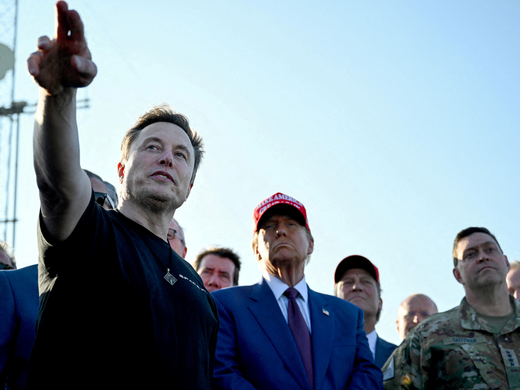Should We Start with a Transatlantic Dialogue?
Is a globally agreed framework for digital governance possible? Would an effort to frame a digital Bretton Woods serve? Or will, as I anticipate and fear, the digital universe fracture into rival, only partly interoperable, segments? Lurking in any effort to address these, or related, questions is the position and ambition of China. Whether Chinese ambition is driven internally, or accelerated by US and Western policy, is secondary to the important fact that it colours the rest of the discussions. Whether the geoeconomics in the years ahead are best characterized as a full-throttle strategic competition, a managed strategic competition modulating the conflicts or a win-win with Chinese characteristics, China’s choices will be central.
During an online conference1 hosted by CIGI and the Policy Institute, the two excellent presentations by Dieter Ernst and Robert Fay laid out the governance challenges of the digital economy and society, both the matter of who develops and deploys the physical technological infrastructure and the rules that guide those societies. In the conclusion, this conference paper suggests that an approach to digital governance must begin with European/North American dialogue on technology development and deployment. That dialogue can, and should, be opened to others.
Addressing the semiconductor challenge, Ernst focuses on an immediate question (the one in the popular press at the moment): the semiconductor supply network and the current shortages. Indeed, the semiconductor case is a crucial instance of, and points to, the broader matter of the physical technological infrastructure. A complementary issue, last year’s popular focus, was raised by the struggle over the deployment of fifth-generation technology, the role of Huawei, and the concern about who, which countries and which companies, control the development, deployment and orchestration of the communications infrastructure.
Chips, we all agree, are the essential elements of the entire assemblage of digitally founded goods and services that are central to the twenty-first-century economy. Moreover, they are strategically crucial in a country’s or a region’ drive for geostrategic position and autonomy — or, if not autonomy, then efforts to limit economic and political dependence. Consequently, there are two questions raised by Ernst. First, what is required to assure supply and access to that supply? Second, how do we avoid weaponizing the supply system?
Laura Tyson and I have laid out our basic views in Project Syndicate (Tyson and Zysman 2021). The objective must be a competitive, resilient, secure and sustainable supply system. One concern is expanding production capacity of all chips, noting that automobiles and artificial intelligence (AI)-enabled server farms require quite different products. Indeed, China’s ambition in AI does require leadership in semiconductor market segments currently dominated by firms such as Nvidia. The shortage itself is partly a product of the coronavirus disease 2019, partly a function of steadily increasing demand for chips in all segments and most products, and partly misjudgments by auto firms about their own needs and how to assure them. By expanding production of commodity, mature products will largely be a matter of money and the availability of equipment. However, the question of leading-edge chips required for server farms, for example, is another matter. A central concern is the dependence of leading-edge chips on essentially one pure-play foundry, Taiwan Semiconductor Manufacturing Company, and two leading-edge producers tied to their own designs and products, Intel and Samsung. Leading-edge foundries are not only expensive, in the $10 to $20 billion range, but as one industry observer remarked, they depend on magic until the processes are fully standardized. Expanding capacity and assuring global supply will require national, not simply industry, agreements. Indeed, it will likely require government-financed collaborations in the development of tools, materials and fabrication.
Along with the issue of assuring supply is the concern that the semiconductor supply chains, and digital infrastructure in general, will be weaponized. When addressing the concerns about weaponizing the supply of both leading-edge and more commodity chips, one must note that each step in the production process is spread widely across national boundaries. That creates choke points, a matter of political, not just industry, concern. Hence the evident question: what will limit disruption at choke points, whether the disruptions have natural origins such as earthquakes, or political sources such as sanctions and restrictions?
To limit choke points and disruptions, whether from political or natural origins, competition is required, ideally from firms of different national roots, throughout the supply chain from materials and equipment through design, and fabrication of both leading-edge and less advanced products. In a fully competitive industry, it would seem that the specific location of particular phases might matter less, and the risk of weaponization would be diminished. Collaboration among Europe, North America and parts of Asia to reduce choke points may indeed be possible.
That said, policy should be designed to address the legitimate concerns that national governments have about the risks to which their economies and firms are exposed as a result of dependence on the choices of other governments, in many cases, the choices of the US government. China, of course, poses a specific and distinct problem. A widely shared concern is that China’s ambitions set it on a course to try to dominate digital technology, broadly defined. Consequently, one policy goal for many governments has been to limit the pace of Chinese advance. Limiting that advance is difficult, and arguably counterproductive, since China is both a significant market and significant producer, though not a producer of the most advanced chips. Note that as a significant internal market and as a market for the production of export products, China is in a significantly different position than was Japan where the internal markets were not sufficient to define the global game. Kenji E. Kushida’s (2011) discussion of the Japanese inability to drive their domestic choices in the case of mobile telephony into global markets captures this. Consequently, restricting Chinese access to product and technology is difficult. Indeed, many firms, including American firms, have made arrangements to bypass government restrictions and sanctions. Restrictions on the flow of technology, therefore, may not only have limited impact on China but may also have blowback effects on Western firms. Yet American policy will, whether one likes it or not, be influenced powerfully by the concerns of China hawks. Whatever one’s view of China, or the policy positions of the China hawks, their influence is a political reality. What, then, is possible?
What policy should be pursued to assure supply while addressing the China challenge? For Europe and North America, and industrial Asia outside of China, the answer must be to run as fast as possible in the development of the underlying technologies, their integration into design and then production systems, as well as the effective deployment of innovative chips into final product. One industry figure with a real knowledge of China remarked that we need to stay two generations of technology, however one might define that, ahead.
There are two approaches to running ahead to consider. First, running ahead means facing, and for the United States facing with allies, the “lab to fab” challenge. Getting new ideas out of the lab, where they may show promise, into a prototype, let alone beta, for venture investment or corporate purchase, is ever more expensive. The equipment costs alone are often well beyond what a university or even corporate lab can pay for early ideas. Consequently, there have been several proposals for a semiconductor commons, in which capital costs are converted into operating costs, perhaps subsidized operating costs. This would allow more innovations to be explored and a faster transition from lab to fab.
Broad allied collaboration is called for in developing such commons. The question, of course, is who can participate? As a start, in the American case, we have argued that funding should come from civilian sources, not military sources (i.e., commerce, not the Defense Advanced Research Projects Agency) to make it easier for allied collaboration. A lab’s or a firm’s participation should be conditional on clear-cut national rules of the lab’s or firm’s home country about technology sharing, intellectual property, market access and the like. A number of specific proposals for such commons have been made. Some examples are plausible and some are not.
Second, rather than a national competitive subsidy of often outdated production facilities, perhaps public-private partnerships, perhaps national alliance partnerships, to generate competitive leading-edge foundries should be considered.
“Governing the Digital Universe: The Governance Problem,” as Fay highlights, of course, goes beyond the terms of competition in the digital equipment and its constituent components, although as in the case of semiconductors, that is essential. Fay is concerned that digital technologies, particularly platforms in my view, are redefining economy and society.2 The digital economy is powerfully shaped by a handful of dominant platforms — platform firms that are, in turn, controlled principally by a few people. Amazon is part of the redefinition of retail markets. Facebook redefines community. Google redefines information access and place. Indeed, does a firm exist in a Western digital marketplace without a presence on Google or, for that matter, Amazon? The parallels in China include Alibaba and Tencent. The digital transformation, moreover, goes beyond these dominant platforms into, as an example, fintech and the tools that may redefine finance, quite aside from blockchain or cryptocurrency.3 Critically, the terms and conditions of these platforms amount to private regulation of public marketplaces, a displacement of, or at least challenge to, government functions. The power dynamics and the consequences for society have recently sparked political responses in Europe, North America and Asia.
A global deal to govern the digital economy and society, the digital universe, is likely a fantasy. We can expect, at best, a patchwork of market and social bargains, often covering some, but not all, regions, a pastiche that despite confusion of rules, driving business to lawyers, still allows global production systems and markets. Amid the diverse political entities that would have to participate in such a global deal, there are radically different views of, and entrenched private interests surrounding platforms, data, the uses of AI and the strategic goals, both military and political. The differences among the United States and North America and, loosely defined, democratic Asia, despite importantly distinct national concerns, are, in my view, likely to be manageable. Resistance to tech giants is growing in both Europe and North America, reflected by a demand for pre-emptive regulation rather than post hoc competition policy that always lags dynamic markets. That trend is reflected in Europe by the proposed Digital Services Act and the Digital Markets Act, both of which are advancing more quickly than expected; in the United States, this shift is reflected by the appointment of Lina Khan at the Federal Trade Commission and proposals emanating from Congress. The likely result of global digital deal making among like-minded allies will be a patchwork with creaks and conflicts, but functional.
However, differences with China are daunting, if not insurmountable. Broadly speaking, there is a rivalry between a state-centred political economy and some version of a liberal political market economy, whatever we mean precisely by either term. At its core, apart from Chinese geostrategic ambitions, is the Chinese leadership’s drive for political control of economy and society. The control and uses of data, of facial recognition for social control, reflect a very different sense of the balance of society and politics from that in North America, Europe and democratic Asia. China’s use of, and control of access to, its domestic market as a mechanism to establish influence in foreign companies and acquire technology creates trade and investment tensions. Layered over the economic and social differences in principle and value is a burgeoning geopolitical and military rivalry that directly influences the meaning of investments in development and deployment of technology.
What can be done to achieve at least a workable patchwork of digital governance? Fay, in his contribution to the conference and this conference paper, calls for a “Digital Bretton Woods.” The Bretton Woods system became the foundation of first a Western international economic governance system and then, with the addition of China and Russia, a more global governance system. Reflecting on the origins and evolution of that system points to the importance of beginning with a European/North American dialogue — a dialogue, and hopefully an alliance, that others may join.
Two aspects of the Bretton Woods development should be emphasized. First, the original architecture of finance and trade was built from American/European dialogue, albeit one dominated by the United States. Following the shift from the original trade framework, the General Agreement on Tariffs and Trade, to its revision, the World Trade Organization began basically the same way. Certainly, the importance of Canada and Japan, particularly through the QUAD discussions, suggests how the world moved from transatlantic-inspired to more globally generated arrangements — though one should emphasize that, in the QUAD discussion, the transatlantic aspects were essential. In the beginning, at least, the United States and Europe dominated finance and trade and, later with Japan, the global economy was dominated in the 1990s by these three (Griffith, Steinberg and Zysman 2017). Second, the Cold War meant that the geostrategic rivals were outside of the economic bargains in the West. Now, of course, our geostrategic, indeed military, rivals are intertwined in the Western economies. Russia, for example, represents a crucial energy source for Europe. China represents a crucial market and “factory” quite apart from its financial holdings.
Consequently, using the image of Bretton Woods as a starting point, let us move back to the beginnings and start with a transatlantic technology dialogue, outside official government channels, focused on tomorrow’s challenges as well as today’s immediate crises. Such an effort should be outside the formal government negotiations to permit a more flexible exploration and include a more diverse set of voices. Such a dialogue would be open to our Asian economic allies, but let us begin with the original Bretton Woods basics, a transatlantic dialogue.
Opening a transatlantic dialogue is important for several reasons. First, such a dialogue would help avoid American technology discussions being organized as a confrontation with China. As noted above, American policy will likely have to accommodate the views of China hawks, but the dialogue should not be shaped by those concerns alone. Second, such a dialogue, if conducted outside official channels, can more easily incorporate the views of a more diverse set of countries that are fundamentally concerned with the social and economic aspects of the digital universe.
Such a discussion should begin by addressing specific concrete issues implied by semiconductors, AI, and specific aspects of the platform economy and society, the practicum of the digital universe. Doing so should allow us to focus on concrete shared concerns and try to generate and infer general rules from solutions to particular cases rather than being caught in ideological visions of the proper economy. Indeed, the resolution of the particular issues is likely to generate a more general vision of the twenty-first-century political economy.
Those of us working toward this hope to have CIGI as a partner.



